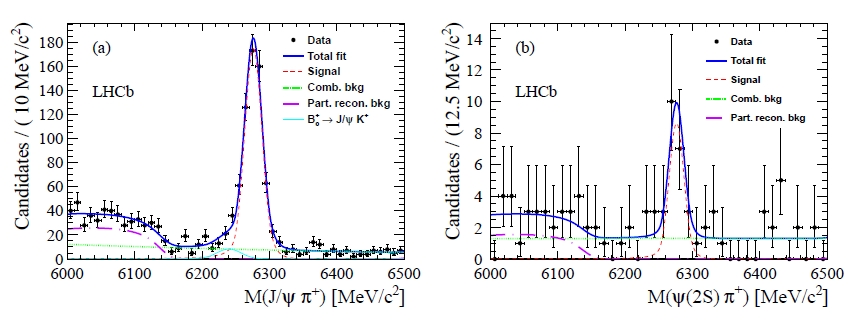The LHCb collaboration published on the Cornell Arxiv yesterday a preprint describing the observation of a rare decay of the B_c meson. In this landscape of failed SUSY searches, no-shows of new resonances in dilepton mass spectra, flat dijet mass histograms, and a general gloomy feeling that the Higgs is all we'll get this decade at the high-energy frontier, it is nice to turn to the beautiful little jewels that are still there to be unearthed in heavy meson spectroscopy.
The B_c meson is a particle made up by a heavy bottom quark and a charm quark. Such a combination used to be a relatively rare occurrence in a hadron collision when the center of mass energy of the collisions is in the same ballpark of its mass, but after its discovery at the Tevatron a few years ago in semi-exclusive decay modes, its fully reconstructed decay to a J/Psi meson and a pion has become available for detailed studies at the LHC. Other decay modes are less straightforward to evidence, but in a sense this makes things more fun! Note that due to the simultaneous presence of two heavy quarks in the meson, which both want to decay by weak interaction into lighter states, the phenomenology of B_c decay is quite varied and interesting to study.
So now LHCb reports of observing (with a significance exceeding five
standard deviations, as required) about 20 decays (20+-5, to be exact)
of the B_c meson into a Psi(2S) and a pion. The Psi(2S) is reconstructed of course in its decay to muon pairs,
which provide for triggering data collection. The clean reference signal
of B_c decays to J/Psi pi also provides a very straightforward
calibration and reference, such that LHCb can measure the branching
fraction of the decay as a ratio.
The result says that the B_c decays
exactly four times less frequently to Psi(2S) pi than it does to J/Psi
pi: the ratio is 0.250 +- 0.068 +- 0.014 +- 0.006, where the first
uncertainty is statistical, the second is systematic, and the third is
related to the knowledge of the ratio of branching fractions to muon
pairs of the two Psi states.
An obligatory figure follows. In it you can see the two twin signals
in the mass distribution of the B_c candidates. On the left the decay to
J/Psi pi, on the right the decay to Psi(2S) pi. I should mention that
LHCb probably uses the rooFit standard of drawing error bars for Poisson
counts, which is fine (the bars encompass the 68% coverage) except that
for zero-event bins these should be extended from 0 to 1.8 events,
while these stop at 1.25, with a smaller coverage than the others. A
detail, admittedly… But if anybody in LHCb is listening: fix that – in
CMS we do it right, why shouldn’t you ?



